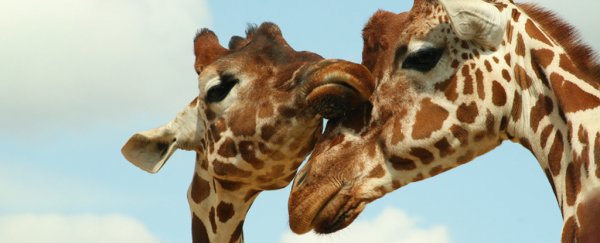Despite their magnificent towering presence, giraffes have somehow managed to keep their social behavior largely under the scientific radar. As it now turns out, we humans have deeply misunderstood these huge animals.
"It is baffling to me that such a large, iconic and charismatic African species has been understudied for so long," said University of Bristol ethologist Zoe Muller.
Until 2000, giraffes (Giraffa camelopardalis) had been dismissed as 'socially aloof'. A 1991 review described the animal as "forming no lasting bonds with its fellows and associating in the most casual way".
While known to roam in herds, individual giraffes appeared to be constantly changing their alliances, leading researchers to believe they do not form strong social ties other than between mothers and their calves.
Now, widespread availability of digital cameras and new methods of analyzing data have revealed these tallest of land animals are actually far more socially sophisticated than they've been given credit for.
In a review of more than 400 studies, Muller and University of Bristol zoologist Stephen Harris have pieced together a wider understanding of the social nature of giraffes.
They found evidence that while lone animals are common, giraffes will also closely associate in small groups of three to nine animals. These often included related adult female pairs, some who have been observed together for up to six years, and mothers with their children - relationships that can persist for at least 15 years.
These groups can consist of up to three generations of related individuals, within which adults help take care of other mothers' calves and have even been seen mourning the death of another individual's baby.
This pattern of female relationships has also been observed in captivity and, along with the observations that males are the ones that disperse from the groups, suggests these animals have matrilineal societies; these social units exist within a wider, fluidly changing group.
"This paper collates all the evidence to suggest that giraffes are actually a highly complex social species, with intricate and high-functioning social systems, potentially comparable to elephants, cetaceans and chimpanzees," Muller explains.
Giraffes are long-lived animals, with females reaching around 30 years of age, but their maximum known reproductive age is around 20. This means they spend about a third of their life as post-reproductive adults. In other species that do this - including elephants, orcas and us humans - grandmothers play a role in helping to raise the next generations.
The researchers suspect this is also the case with giraffes, but note it has yet to be documented and requires further investigation. They also note complex cooperative social systems like what they're suggesting here require complex communication abilities; however, just like many other aspects, giraffe "communication systems are poorly understood."
These mammals are not particularly noisy and remain the only vertebrate species not known to yawn, although they do cough, whistle, grunt, and even eerily hum to each other at night (listen below). They also visually communicate with their ears and postures, which may all form part of their communications repertoire.
Giraffes "have evolved highly successful and complex societies, which have facilitated their survival in tough, predator-filled ecosystems," said Muller.
Sadly, giraffe populations are now in freefall - having declined by 40 percent since 1985 - and they're listed as vulnerable on IUCN's Red List of Threatened Species.
"Recognizing that giraffes have a complex cooperative social system and live in matrilineal societies will further our understanding of their behavioral ecology and conservation needs," Muller concluded.
This research was published in Mammal Review.
